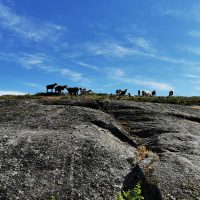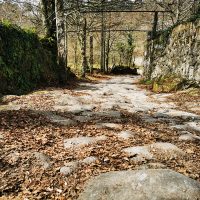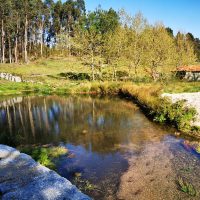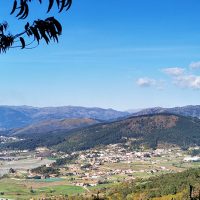Sobre o local
A GR117 – Via Romana XVII entra no concelho da Póvoa de Lanhoso pela extremidade oeste da freguesia de Covelas e cruza toda a Serra do Carvalho, contemplando-se uma soberba paisagem sobre o vale do rio Cávado e a Serra do Gerês. Depois de transpor a Estrada Nacional 205, já no lugar do Pinheiro, freguesia de Lanhoso, o percurso passa em frente à bem conservada Capela do Senhor do Socorro com destino ao Monte do Pilar, devendo-se visitar o Castro de Lanhoso, importante povoado da Idade do Ferro, o Santuário da Nossa Senhora do Pilar, belíssimo exemplar de arquitetura religiosa de devoção mariana, e o Castelo de Lanhoso, classificado como Monumento Nacional e admirável reduto medieval que tantas vezes serviu de proteção a D. Teresa, mãe de D. Afonso Henriques, primeiro Rei de Portugal.
Retomando o traçado da Via Romana XVII, o percurso segue um caminho de terra batida até atravessar o Ribeiro do Pontido, já em direção ao Centro de Interpretação do Carvalho de Calvos. Aqui, pode-se percorrer este espaço ambiental dedicado à utilização responsável e eficiente dos recursos naturais e repousar debaixo dos ramos deste magnífico exemplar da espécie Quercus Robur, com mais de 500 anos.
Um pouco mais à frente, o pedestrianista pode contemplar uma considerável extensão de lajeado bem conservado, no lugar da Botica, freguesia de Calvos.
A partir daqui, o trajeto retoma um caminho de terra batida e entra numa mancha florestal interrompida, aqui e ali, pelos característicos núcleos rurais e campos agrícolas, geometricamente distribuídos e que formam belíssimas mantas de retalhos. Depois de cruzar a Estrada Nacional 103, já na freguesia de Serzedelo, atravessa-se um frondoso carvalhal alcançando a capela de Santa Luzia, espaço religioso que delimita a fronteira administrativa desta Grande Rota em território povoense, continuando o percurso pelo antigo traçado deste primitivo e importante eixo viário romano que ligava Bracara Augusta (Braga) a Asturica Augusta (Astorga).
Download do Percurso: KMZ | GPX
🇬🇧 TRAIL DESCRIPTION 🇬🇧
The 117 Via Romana XVII Great Route Trail enters the Póvoa de Lanhoso territory through the western extremity of the Covelas parish and crosses the entire Serra do Carvalho, offering superb views over the valley of the Cávado River and the Gerês Mountain Range, part of the National Park. After crossing the National 205 road (N205), in Pinheiro, Lanhoso parish, the trail passes in front of the well-preserved Senhor do Socorro Chapel, heading to the Monte do Pilar, where one should take a small detour and visit the Castro de Lanhoso, an important settlement from the Iron Age, the Nossa Senhora do Pilar Sanctuary, a beautiful example of religious architecture of Marian devotion, and the Lanhoso Castle, listed as a National Monument and an admirable medieval stronghold that many times served as protection to Lady Teresa, mother of D. Afonso Henriques, the first King of Portugal.
Returning to the route of the Via Romana XVII, the trail follows a dirt track until it crosses the Ribeiro do Pontido, already on the path of the Carvalho de Calvos Interpretation Centre. Here, you can walk through this environmental space dedicated to the responsible and efficient use of natural resources and rest under the branches of this magnificent more-then-500-year-old specimen of the Quercus Robur species (Oak).
A little further ahead, the pedestrian can contemplate a considerable stretch of well-preserved stone slab in the village of Botica, in the parish of Calvos.
From here on, the trail resumes a dirt track and enters a forest area interrupted, here and there, by the characteristic rural nuclei and agricultural fields, geometrically distributed and forming beautiful patchwork rugs. After crossing the National 103 road (N103), already in the parish of Serzedelo, we cross a leafy oak tree and reach the Santa Luzia chapel, a religious space which marks the administrative boundary of this Great Route in the Póvoa de Lanhoso territory, continuing the route along the ancient route of this primitive and important Roman road which linked Bracara Augusta (Braga) to Asturica Augusta (Astorga).




